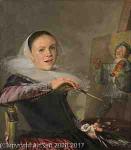Judith Leyster
Judith Leyster
نمط: Baroque;
مكان: Haarlem
مولود: 1609
الموت: 1660
سيرة ذاتية:
Judith Jans Leyster, also known as Judith Leijster, was a painter from the Netherlands, born on July 28, 1609, and died on February 10, 1660. She is renowned for her genre works, portraits, and still lifes, which were initially attributed to Frans Hals or her husband Jan Miense Molenaer. However, in 1893, Hofstede de Groot first attributed seven paintings to her, six of which are signed with her distinctive monogram 'JL*' https://Wikioo.org/@/Judith-Leyster.
Early Life and Training
Leyster was born in Haarlem as the eighth child of Jan Willemsz Leyster, a local brewer and clothmaker. While the details of her training are uncertain, she was already well known in 1628 to be mentioned in a Dutch book by Samuel Ampzing titled Beschrijvinge ende lof der stadt Haerlem. She may have learned painting from Pieter Fransz De Grebber, who was running a respected workshop in Haarlem in the 1620s.
Artistic Style and Career
Leyster's first known signed work is dated 1629, four years before she entered the artists' guild. By 1633, she was a member of the Haarlem Guild of St. Luke. Her self-portrait, c. 1633, is a significant work that marks a historical shift from the rigidity of earlier women's self-portraits, in favor of a more relaxed, dynamic pose. This painting is comparable to those by Frans Hals, and it is very relaxed by the standards of any Dutch portrait. Leyster's oeuvre includes dozens of paintings, mostly genre works, portraits, and still lifes. Her domestic genre scenes are particularly innovative, showcasing quiet scenes of women at home, often with candle- or lamplight. The Proposition is an unusual variant on these scenes, said by some to show a girl receiving unwelcome advances.
Legacy and Significance
Leyster's work has been recognized for its ability to capture the essence of human experience. She was a pioneer in her field, and her legacy continues to inspire artists today. Her paintings can be found in various museums, including the Mauritshuis in The Hague.
- Leyster's monogram 'JL*' is a play on words, referencing the Dutch term for "Lead star," which was also the name of her father's brewery.
- She may have worked collaboratively with her husband, Jan Miense Molenaer, who was a more prolific artist.
- Leyster's paintings are characterized by their relaxed and dynamic poses, which were unusual for women's self-portraits at the time.
In conclusion, Judith Leyster was a significant figure in the Dutch Golden Age painting, known for her genre works, portraits, and still lifes. Her legacy continues to inspire artists today, and her paintings can be found in various museums around the world. For more information on Leyster's work, visit https://Wikioo.org/@/Judith-Leyster.
Wikipedia link: Click Here














